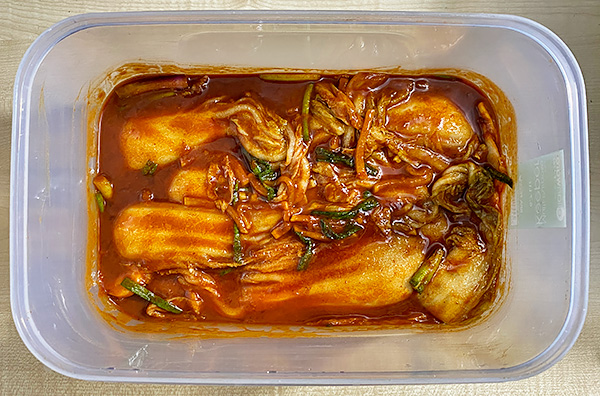|
Kimchi is a staple
of Korean cuisine. There are hundreds of variations of this
food. It is essentially a cold lacto-fermented vegetable. The
main vegetable is cabbage (napa or
wombok variety; baechu is the Korean word for
napa cabbage) with radish, spring onions and carrots
added.
Here is how I made
a spicy batch up:
General
precautions
-
You are making
a food product.
Exercise maximum hygiene/sanitation in all your procedures.
-
The hot
compound in chillis is capsaisin.
Avoid contact with mucous membranes (e.g. eyes and
nose);
Wear gloves when needing to be in skin contact.

Ingredients for
making kimchi
Method
-
Wash one large
head of wombok cabbage. Split length-wise into four
quarters.
-
Find a large
container to sit the cabbage in.
-
Begin
liberally adding table salt to the cabbage, making sure to
dust in between the leaf folds.
-
Set the salted
cabbage aside for at least two hours.

The cabbage just after salting
-
While the
cabbage is salting, prepare the kimchi paste.
-
Squash and
peel 4 - 5 cloves of garlic, about an inch of ginger, and
one large onion.
-
Blend all
three ingredients.
-
To the blended
aromatics, add three or four (or as much as you like
for your preferred palate) large tablespoonfuls of Korean
hot pepper paste (hot chilli):

This is the Korean hot pepper paste which I used
or you can use
Korean hot pepper powder:

-
Add about 50
mL of fish sauce to the paste.
Judge this carefully as this is one of the sources of salt
in the fermentation.
There should be sufficient salt to provide for the
conditions which favour lacto-fermentation to the exclusion
of other microbial proliferation.
-
Optional:
Add about 50 mL of fermented shrimp (cincalok) to the
paste.
I also added about 25 mL of fermented brine from my
lacto-fermented
chilli batch.
-
To about 150
mL of water, add two large tablespoonfuls of rice flour (or
any starch), and two tablespoonfuls of sugar.
Stir constantly as you bring it to the boil over heat.
Set aside and let it cool.
When cool, combine this thick gelatinized mix with the paste
mixture which you have prepared above.
-
Slice one
small radish into matchsticks.
Slice a bunch of spring onions into inch-long lengths.
Slice one carrot into matchsticks.
-
Add the sliced
vegetables to the paste mixture above and mix well.
-
It is now time
to wash the salted cabbage.
It is kimchi and not salted vegetable which is being
made and so as much salt as possible needs to be washed out
from the initial brining. The brining stage serves to crisp
up the cabbage by causing the withdrawal of water from the
cabbage tissues via osmosis. Indeed one should see a collection of water
around the cabbage at the end of the two hour brining
period.

The cabbage after two hours of salting
-
Soak the
cabbage in fresh water and discard.
-
Repeat this
step as many times as necessary to rid the cabbage of
external salt. Taste the cabbage to see how the desalting is
progressing. A well-washed product should be just mildly
salty (from internal salt which has imbibed into the cabbage
tissues rather than from external salt).
-
Then drain and
remove as much water as possible from the cabbage (squeeze
the leaves if necessary).
-
You are now
ready to add the paste to the washed cabbage.
Spread the paste amongst the cabbage, making sure that that
areas in between the leaf folds are coated with paste.
-
Tamp the
cabbage into the container to be used to expel as much air
as possible.
Ensure that the cabbage is well covered by the paste juices
at the end of the tamping:

Cabbage and added
vegetable slices tamped into a
containerand ready to begin lacto-fermentation.
-
Cap and the
place the container in a cool corner of your kitchen for a
day or so to let the microbes proliferate and begin
fermentation.
-
After the
initial incubation, place the container ina refrigerator to begin the slow,
cold-temeprature lacto-fermentation.
This simulates the production of winter
kimchi in Korea where the cabbage is fermented in the
cold outdoors, in earthen jars (onggi) buried
in the ground.
-
You may wish
to eat the kimchi fresh (at the start of
fermentation).
When eaten fresh, the product is called baechu geotjeori.
-
It will take 2
- 3 weeks for your kimchi to be ready via cold
fermentation.
Do taste the product through time to see how it is
progressing.
-
Kimchi
should keep a very long time in the refrigerator (3 - 6
months).
|





